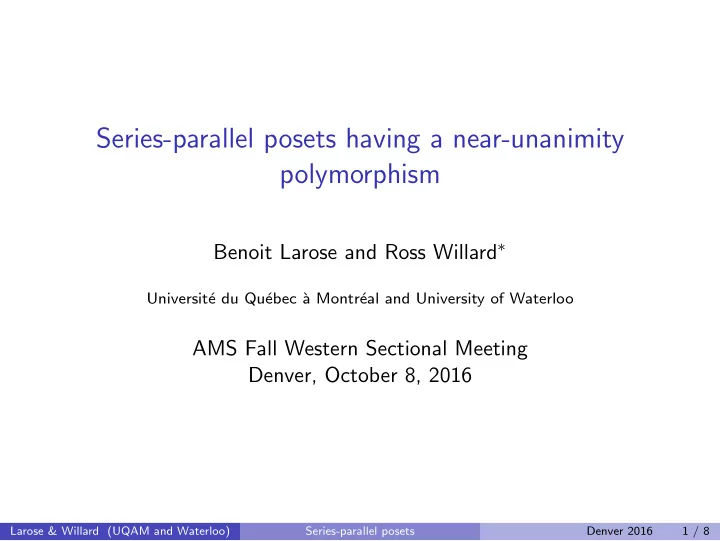

Series-parallel posets having a near-unanimity polymorphism Benoit Larose and Ross Willard ∗ Universit´ e du Qu´ ebec ` a Montr´ eal and University of Waterloo AMS Fall Western Sectional Meeting Denver, October 8, 2016 Larose & Willard (UQAM and Waterloo) Series-parallel posets Denver 2016 1 / 8
All posets are finite. If P , Q are posets, then P + Q is their ordinal sum : = + P ∪ · Q is their disjoint union. 1 = 1 ∪ · 1 = = 2 1 + 1 = Larose & Willard (UQAM and Waterloo) Series-parallel posets Denver 2016 2 / 8
Definition . Let P be a poset. A function f : P n → P is a near unanimity (NU) polymorphism of P if n ≥ 3. ∀ 1 ≤ i ≤ n , ∀ a , b ∈ P , f ( a , a , . . . , a , b , a , . . . , a ) = a ↑ i f is monotone in each variable. Clone theorists (last century) and CSPers (this century) care about which posets have an NU polymorphism. Larose & Willard (UQAM and Waterloo) Series-parallel posets Denver 2016 3 / 8
Key examples T 2 = T 3 = T 4 = = 1 + 2 + 2 + 1 Facts Every lattice-ordered poset has an NU polymorphism of arity 3. T 2 : Has an NU polymorphism of arity 5 (Demetrovics et al, 1984). T 3 : Does not have an NU polymorphism. (Demetrovics et al, 1984) Does have “weaker” (Taylor) polymorphisms (McKenzie, 1990). T 4 : Does not even have “weaker” polymorphisms (Dem. & R´ onyai, 1989). Larose & Willard (UQAM and Waterloo) Series-parallel posets Denver 2016 4 / 8
T 2 , T 3 , T 4 , . . . are examples of series-parallel posets . Definition A poset is series-parallel if it can be constructed from (copies of) 1 by finitely many applications of + and ∪ · . Equivalently (Valdes, Tarjan, Lawler 1982), a poset is series-parallel iff does not embed into it. Dalmau, Krokhin, Larose (2008) characterized those series-parallel posets which have “weaker” (Taylor) polymorphisms: By “forbidden retracts” (list of 5, including T 4 , 2 + 2 , and 2 + 2 + 2 ). By an internal characterization, easily checkable in polynomial time. Our main result : We can do something similar for NU polymorphisms. Larose & Willard (UQAM and Waterloo) Series-parallel posets Denver 2016 5 / 8
△ New operations: P Q , P △ Q , P Q , and P ♦ Q ⊳ ⊲ P Q : defined when P has 1 and Q has 0. ⊳ ⊲ P △ Q : defined when both P and Q have 1. △ P Q : defined when both P and Q have 0. P ♦ Q : defined when both P and Q have 1 � = 0. = = △ ⊳ ⊲ = = △ ♦ Larose & Willard (UQAM and Waterloo) Series-parallel posets Denver 2016 6 / 8
Here is our result. Theorem Let P be a series-parallel poset. TFAE: 1 P has an NU polymorphism. 2 P does not retract onto 2 + 2 , 2 + 2 + 1 or its dual, or T 3 . 3 Each connected component of P having more than one element is in △ the closure of { 1 + 1 } under + , ⊳ , △ , , ♦ . ⊲ Larose & Willard (UQAM and Waterloo) Series-parallel posets Denver 2016 7 / 8
About the proof: 1 Hardest part is showing that P being in the closure of { 1 + 1 } under △ + , , △ , , ♦ implies P has an NU polymorphism. ⊳ ⊲ 2 Use a complicated induction on the construction of P . 3 Do not actually construct an NU; instead, use criterion for existence due to Kun and Szab´ o (2001). Thus we have no control over (and know nothing about) the NU’s arity. Problem For fixed k ≥ 3, characterize the series-parallel posets which have a k -ary NU polymorphism. Added post-lecture: the above problem is solved by Corollary 3.3 of L. Z´ adori, Series parallel posets with nonfinitely generated clones, Order 10 (1993), 305–316. Larose & Willard (UQAM and Waterloo) Series-parallel posets Denver 2016 8 / 8
Recommend
More recommend